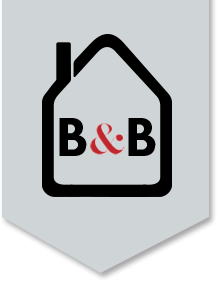Tiny Kitchen Design
How to make the most of your tiny kitchen design
How to make the most of your tiny kitchen design
What, Why & How to be Zero Waste
Find out how to downsize your closet effortlessly and seamlessly
Learn how to Design your Tiny House!
When downsizing, looking at your “why” is essential. Why is it important to you? What is the purpose of downsizing? No matter if it’s money, a desired lifestyle, family, or something more, the bigger your “why” the more drive you’ll have to get rid of excess and live in your downsized space. – Tiny House Community
While deciding what to keep when downsizing can be extremely challenging, it’s helpful to separate the items you need from the items you want. You may have a gorgeous TV stand and large DVD collection, but practical thinking might instead have you wall-mounting your flat-screen and streaming movies instead. Things that previously would’ve been owned by each member of the home, like a closet or other clothing storage, can instead be treated communally and shared by all. For those considering moving to a modular tiny home, many builders offer optional loft areas for storage. – Wolf Industries
As van travel aficionados, we’ve learned a thing or two about living with less over the years. Our shortlist for downsizing success includes a thoroughly organized list of needs versus wants, multi-purpose items (think Swiss Army knives for starters), and the mental realization that you don’t need a lot of material things to be happy. From working on-the-go to being in a small space with our partners for long trips, we’ve gotten better through trial and error. Not to mention, we’ve got storage down to a fine art. Never underestimate the power of under-bed drawers and collapsible furniture! – Voyager Camper Vans
Start by gathering up all the things you think you need in one place. Chances are you’ll fill up the room! Then group similar things – put your clothes together, cookware, tools, equipment, etc. Now you can start reducing in a very visual way seeing your piles get smaller. Clear out any duplicates or multiples. Consider getting rid of any “single-use” item like a tea kettle. A cooking pot can do double duty by heating water and cooking. You can also evaluate each item in terms of how often you’d use it in a typical week or month. – Vanlife Outfitters
Downsizing is difficult, but once you have freed yourself of your nonessential ‘stuff’, you will find you have so much more freedom. A van is a tiny home on wheels, but if designed carefully, affords you the opportunity to be thoughtful about every inch. We are big fans of clothes cubes and IKEA style storage bins to throw into cabinets. We love the clever use of wall and ceilings space – we have fishing rod holders on the ceiling of one of our vans and hooks strategically placed all over. It’s tough in the beginning but as soon as you get a system in place, it’s second nature. – Aspen Custom Vans
We are firm believers in Pareto’s Principle (the 80/20 rule). We use 20% of our belongings 80% of the time and vice versa. Moving into an alternative living space (like a van) requires an honest inventory of how often you use the majority of your belongings. Many people, that downsize and simplify, find that they are much happier, more focused, and balanced with fewer belongings.
To anyone considering moving into a van – get rid of almost everything you haven’t touched in the last 60 days. In most cases, you can live without it. Believe it or not, you can live without the toaster oven, blender, and panini maker (all of which typically get very minimal, to begin with). – Vancraft
Living in a camper van is the extreme end of tiny home living, therefore you should always ensure each item you own is something you’ll use regularly and won’t easily break – emphasize quality, not quantity on every item you choose to keep. The camper van community loves to share their unique ideas so use the people to your advantage! Reach out, ask questions, and offer to share your own ideas as the best advice comes from someone who is currently living successfully small. – Boho Camper Vans
Here are a few tips: Think small. You will find a smaller version of everything you ever owned: plates, utensils, cups, blankets, etc.
Think collapsible. Many outdoor brands are doing the work for you already: collapsible containers, sinks, foldable tools, compact ovens, etc. They’re usually fun to use as well!
Think optimized. When you think you’re done organizing, think again. Maybe you can fold your t-shirts more effectively, allowing you to have one more in your cabinets. Optimize. Optimize. Optimize. – Vanlife Customs
I always recommend finding a permanent home for everything. Use drawer dividers, spacers and packing cubes. It keeps everything nice and tidy. Keep a laundry bag to store dirty laundry away from your clean items. Have a dedicated space that holds your cleaning supplies including a broom! Keeping your new tiny home tidy is one of the most important pieces of advice! It’ll feel bigger and you’ll be happy to go to bed at night knowing your new home is clean. It also makes finding items and making food a lot more pleasant. – Roamerica
When our tiny house customers ask us to build in storage systems, I always encourage them to begin living in the space before permanently committing to the location of their storage. After you begin using your new space, you get a better feel for which areas can be used for short-term storage and long-term storage (and maybe even which items you no longer need). Once you’ve determined that, you may decide to have storage built-in, or often you can find great storage solutions at IKEA at a fraction of the cost of built-ins. – Carriage Houses NW
Organization and cleanliness are key, especially in a tiny home. When we first downsized, one of our biggest frustrations was tripping over muddy hiking shoes in the morning. Having a dedicated space for wet or smelly items made all the difference. Packing these items in an exterior compartment or a well-ventilated area will keep your home smelling fresh. – Parked in Paradise
Get creative! When one goes tiny there is very little room for excess. In the case of a houseboat, van, and some tiny homes, you will encounter a much different bathroom experience. Whether it is water limitations because of tank capacity or just general space in a bathroom, B&B has a lifehack for this. Take advantage of facilities in your surrounding areas. A gym membership will promote a healthy active lifestyle and give you access to a social atmosphere, showers, towels, hygiene products, and a general mental stimulus to occupy a portion of your day. Getting comfortable using a gym or clubs’ facilities could make the transition from a multiple bathroom situation down to a tight one bathroom household much easier. The money saved from the downsizing can usually more than cover your membership to these facilities. – B&B Tiny Houses
Choose items that can be used for multiple purposes when deciding what to take with you. For example, when we are building a van, we use a couch that turns into a bed and also has storage available below. Why not think that way when you pack? – Sportsmobile
With downsizing, there are two major things that have helped me in my minimalism journey. The first is to keep and pursue belongings that are dual purpose. If something can’t serve me in more than 1 way, I try to donate it, or simply just don’t purchase new items that don’t have a dual purpose. The second most important thing is to consolidate my belongings into 1 quality item. For example, when I moved into a van I had 5 pairs of black leggings – some were old, some had holes in the knees, etc. I donated all 5 and invested in a single high-quality pair and that new pair has now lasted me for multiple years. I apply this same principle to many items: drinking cups, shoes, backpacks, hiking gear, and more. It’s really made a difference! For more inspiration, you can also check out our Instagram here. – So We Bought A Van
Since Outside Van is a fully custom van conversion company, we encourage vanlifers to be unique when designing their one-off vehicles. Since a van has limited space, focus on functional systems like power, solar, heat, and water. Just because a van looks good in photos doesn’t mean it’s a high-performing, functional vehicle for full-time living. And you might reconsider needing a toilet. – Outside Van
When preparing to move into a small space don’t limit your planning to where you will store things you want to keep, but also consider how you will manage your waste. Trash, recycling, and food waste can build up faster than you expect. Your beautifully designed space can quickly become a nightmare when three-day-old cans of tuna are left overflowing from your trash. Consider what waste a product will create before you buy it. – Vanvaya
We all have boxes of records, stacks of magazines and catalogs, unwanted piles of old bills, envelopes, lists, notebooks, etc. Every cubic inch of a tiny home is loaded with intention and care for how the space looks and feels; a couple of boxes worth of this stuff could be lifestyle defining. It might mean you couldn’t have a chair for a friend when she visits, some sports equipment you’ve been wanting, or space for plants and animal friends. Scan it, upload it onto a computer and throw it onto a hard drive. Instead of books, music CDs, and Movies on DVD, transition to eBooks, Netflix and Spotify to declutter your collections.
Additionally, you can always consider moving somewhere warm so that your clothes are smaller, and you need less of them. – TruForm Tiny Homes
In an era when modern life is fast-paced, more demanding and stressful, slowing down and savoring life can be hard. Costs of living are increasing all over the world, from Hong Kong to San Diego, so communities of ambient folk living on residential boats, camper-vans, trailers and static homes are gaining popularity as people escape the urban squash. Downsizing will mean that personal space is at a premium. While it can be a hugely bonding experience, you will be asking your loved ones to kindly move so you can pass every time you walk from the kitchen to the bedroom. It’s impossible to be materialistic, as there simply isn’t room to store anything surplus to absolute requirement. Cooking becomes simplified, clothing whittled down to necessities and trinkets a thing of the past. – Rightboat
One of the most valuable things we can suggest when preparing to move into a smaller space is to make sure you are on the same page with your partner/housemates. Though you might think it’s not a big deal to throw away that box of high school trophies your wife has been lugging around for four years, it might be something they don’t want to toss. Make sure you do a visual assessment of your current space and then figure out a plan to downsize together. Perhaps there’s a designated area where you can put things you want to toss that everyone can look over before they actually end up in the dumpster or at Goodwill. – Authentic Asheville
Choosing to live a smaller, simpler life with your partner is often a challenging yet incredibly rewarding experience. My advice: don’t expect a tiny house to fix anything in your relationship; what it will likely do instead is to intensify everything. To be successful, it takes an increased focus on good, honest communication and kindness, moment to moment, to make sure each of your needs is met. This means designing your house (or lifestyle) to be sure both of you have the physical space (and time to yourselves) needed to thrive. If done with care, a shift to a smaller (even tiny house) lifestyle can bring you both more joy, intimacy and freedom. – The Tiny Project
Originally published on Redfin
You’ve seen beautiful tiny houses on wheels on TV, in magazines, and on the internet. You could see yourself buying a tiny house one day. You could use it for vacations, put it in your backyard to use as a studio or guest house, or you could live in your tiny house full-time.

In this photo: The Hoosic Tiny House
But you may have asked yourself: if it’s on wheels, how does it really work? How do you get power to a tiny house? How do you get fresh water in and waste water out? How are tiny houses climate controlled? What expenses are you forgetting to include in your overall budget?
There’s a lot more to buying a tiny house than just buying the tiny house. You’ll need to have a good understanding of how it all works, and how you’ll deal with fresh water, waste water, power, and parking. There are many options for different types of tiny house setups. Before building, your builder will need to know how you plan to use your house so he or she can help you choose the best appliances and systems for your specific situation. Read about tiny house design sessions.
Because they’re on wheels, tiny houses can travel. However, life on the road isn’t for everyone: most tiny house dwellers live in one place with permanent utility connections.
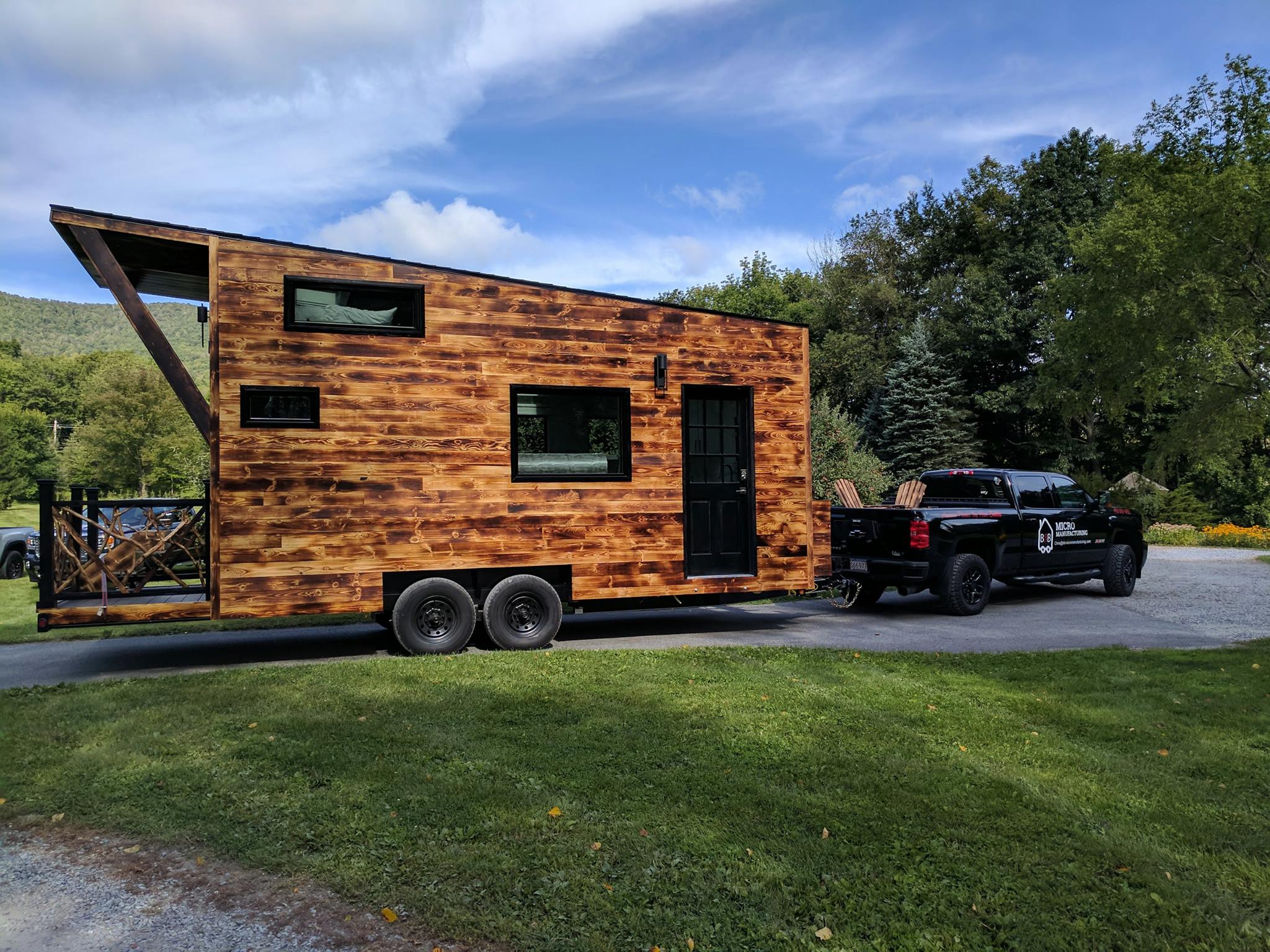 If you’re traveling with your tiny house:
If you’re traveling with your tiny house: If your tiny house will stay in one place:
If your tiny house will stay in one place:Most people place their tiny house on a gravel or concrete pad. This keeps utility lines in place and systems working properly (for example, some mini splits can leak if they’re not level).
Anchors are a great idea: they’ll keep your house from shaking even in the worst weather.
Skirting, while not necessary, also reduces shaking in high winds, and, if insulated, helps keep your pipes from freezing. Skirting creates a more permanent look to your tiny house.
If you don’t have a location for your tiny house yet, here are some things to consider when looking:
If you’ll be placing your tiny house in a backyard, here are some tips:
Photos in this section: The Arcadia Tiny House and the Spectacle Tiny House (a custom-built park model that’s not in our catalogue).
When people envision life on the road, they picture a life of freedom. But if you’re a human, you’ll still need water for life’s basics: drinking, cooking, and bathing.
For water, RV hookups come standard on B&B Tiny Houses. RV hookups have an inlet for a fresh water hose and an outlet for waste water. You can connect the hoses to a hookup pedestal at an RV park or, if your tiny house is in a backyard, to the main house.
Tiny houses on wheels have four potential spaces where water is used: kitchen sink, bathroom sink, shower or bath, and toilet. Depending on whether you’ll be traveling or staying put, and what systems are available at your location, we’ll help you decide on the best type of toilet for your lifestyle.
If you’re traveling, here’s how to hook up your tiny house at a campground:
Some tiny houses have water tanks and some don’t. If you’ll always be hooked up to a water system when you’re using water, you won’t need water tanks.
If your tiny house has water tanks, the tanks can store fresh and waste water until your house gets to a pumping station.
If you have water tanks, here’s a video on how to empty waste water (black water) tanks at a dumping station.
If your tiny house is staying in one place, you’ll want a more maintenance-free water system. Tiny houses on wheels can be hooked up permanently to the same systems traditional houses use: a well or city water for fresh water, and septic or sewer for waste water.
If your tiny house is in the back yard of a traditional house, you can hook your tiny house up to the existing water system, as long as it has the capacity to add another “bedroom”, which is code for “the water usage equivalent of one or two people being added to a house”. Generally, when houses are built, the water system permits the house to add at least one extra bathroom, in case the house gets an addition in the future.
Generally, we advise our customers not to DIY sewer connections, as there’s too much that can go wrong. However, we want you to have an understanding of how it’s done, so please watch the following video of how one DIYer connected his RV to the sewer.
Power is the second most important utility your tiny house will require. If it’s good weather outside, you can survive without using power, as if you’re going camping. But if you want to take a hot shower, operate lights and other electronics, and generally live like a modern human, you’ll need a constant source of power going to your tiny house.
 Most tiny houses on wheels come with RV hookups where you plug an extension cord with an adapter into the side of your house.
Most tiny houses on wheels come with RV hookups where you plug an extension cord with an adapter into the side of your house.
We hope this explanation of the many ways to set up your tiny house was helpful. In your design session, we’ll ask you to describe what your living situation will be and we’ll go over the best options for your specific situation.
Here’s an article that walks you through the 8 steps of buying a tiny house. When you’re ready to buy your tiny house, contact us to get started!
Thank you to YouTubersSean and Kristie Michael of Long Long Honeymoon, Mark Rowles, and BuckWSR for their instructional videos.
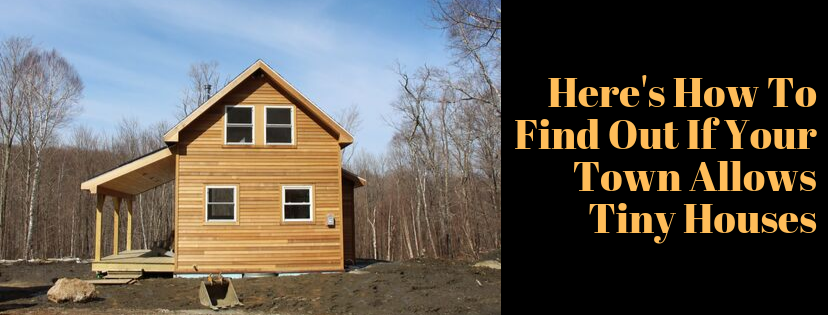
Zoning codes for many municipalities can be found on your town’s website or on ecode360.com.
Here are some helpful search terms:
If you’re hoping to put a tiny house ON WHEELS either on its own property or on a property with other buildings:
If you’re hoping to build a backyard cottage ON A FOUNDATION:
If you’re hoping to build a small house ON A FOUNDATION on its own piece of land:
Appendix Q for tiny houses on foundations:
If you’re hoping for a tiny or small house ON A FOUNDATION, look into whether your state has adopted Appendix Q for tiny houses into its building code. Appendix Q is a set of safety standards for houses on foundations that are 400 sq. ft. and under, basically providing standards for how lofts and ladders are built. More info on Appendix Q for Tiny Houses here. If your state hasn’t adopted Appendix Q, that doesn’t necessarily mean you can’t build small: it just means you’ll have to follow your state’s existing building code for lofts and ladders, and the other details in the Tiny House Appendix.
On January 1, 2020, Massachusetts and California simultaneously will join Maine, Idaho, Oregon and Georgia as the first six states to adopt the Tiny House Appendix into their building code. Many other states are in the process of adopting the Tiny House Appendix. The Tiny Home Industry Association has updates on Appendix Q across the United States.
Please note: there may be more lenient rules depending on whether your tiny house will be used seasonally, as a “guest house”, “camper”, or “cabin” rather than as a full-time, permanent residence. If you’ll only be using your tiny house sometimes, residential zoning laws and building codes may not apply. Check in with your municipality if this is the case.

Photo: Arcadia Tiny House on Wheels. This tiny house can travel, and it’s certified as an RV. It’s currently being used as a guest house at Woodlife Ranch; it isn’t someone’s permanent home.
If you can’t find any info on tiny houses in the town’s zoning but would like to know whether a tiny house on wheels or on a foundation would be legal to live in full-time, send a quick email to your town’s building inspector or zoning board (you can find their contact info on your town’s website).
Be sure to include the following information:
They’ll be able to tell you whether tiny houses are legal.
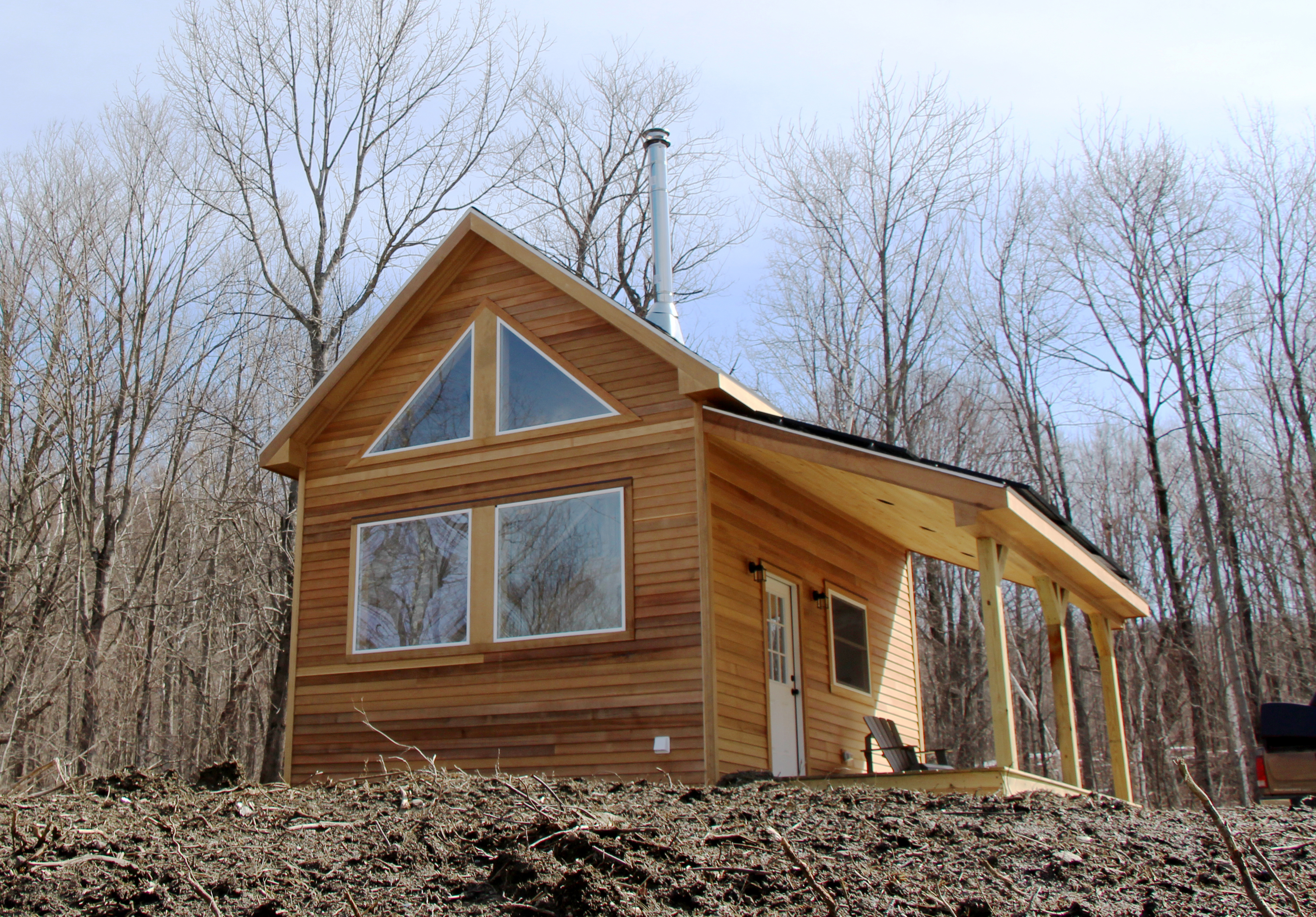
Photo: Green River Small House. This house was built on-site, piece by piece, and it is compliant with local zoning bylaws and state building code. It’s being used as a permanent, year-round home.
If tiny houses are not currently included in the zoning bylaws, your zoning board will be able to advise you whether it’s worth pursuing a change to the zoning bylaws. Generally this process takes a while, and the zoning board will guide you through it. You don’t have to be an expert to request a zoning change, just an interested citizen! Be prepared with knowledge of how having tiny houses would help your town or city. Here are some examples, which you can tailor to the specific needs of your municipality:
It’s best to do this before you have your tiny house built. This way, you can be flexible in your design, making sure it conforms with the standards the town creates.


1. Downsize gradually. This process doesn’t have to be a stressful one: as long as you go slowly and thoughtfully, downsizing can be a fun way to reminisce and for many, a cathartic relief. The best way to get started is to figure out what you don’t use. Arrange your in-season clothing on hangers facing backwards. After you wear and wash a piece of clothing, replace it on a hanger facing forwards. After a few months, say goodbye to all the pieces of clothing you didn’t use. Repeat this process in winter and summer. Similarly, in the kitchen, clear out one or two cabinets and mark them. When you use a cooking instrument, put it away in the marked cabinet. After a couple months, get rid of everything you didn’t use.
2. Less is more in your decor. Pare down your collection of objets d’art to a couple small pieces. You’ll want to use the small amount of space you have for things you can use and not be sifting through knick knacks to find them. Likewise, be sure the objects you use every day that are kept within view are pleasing to the eye: they will become part of your new decor scheme. Consider multi-use furniture as well; although things like Murphy beds and fold-up tables can be more expensive and you’d have to rearrange your house daily, with multi-use furniture you can save space and simplify the look of your home.
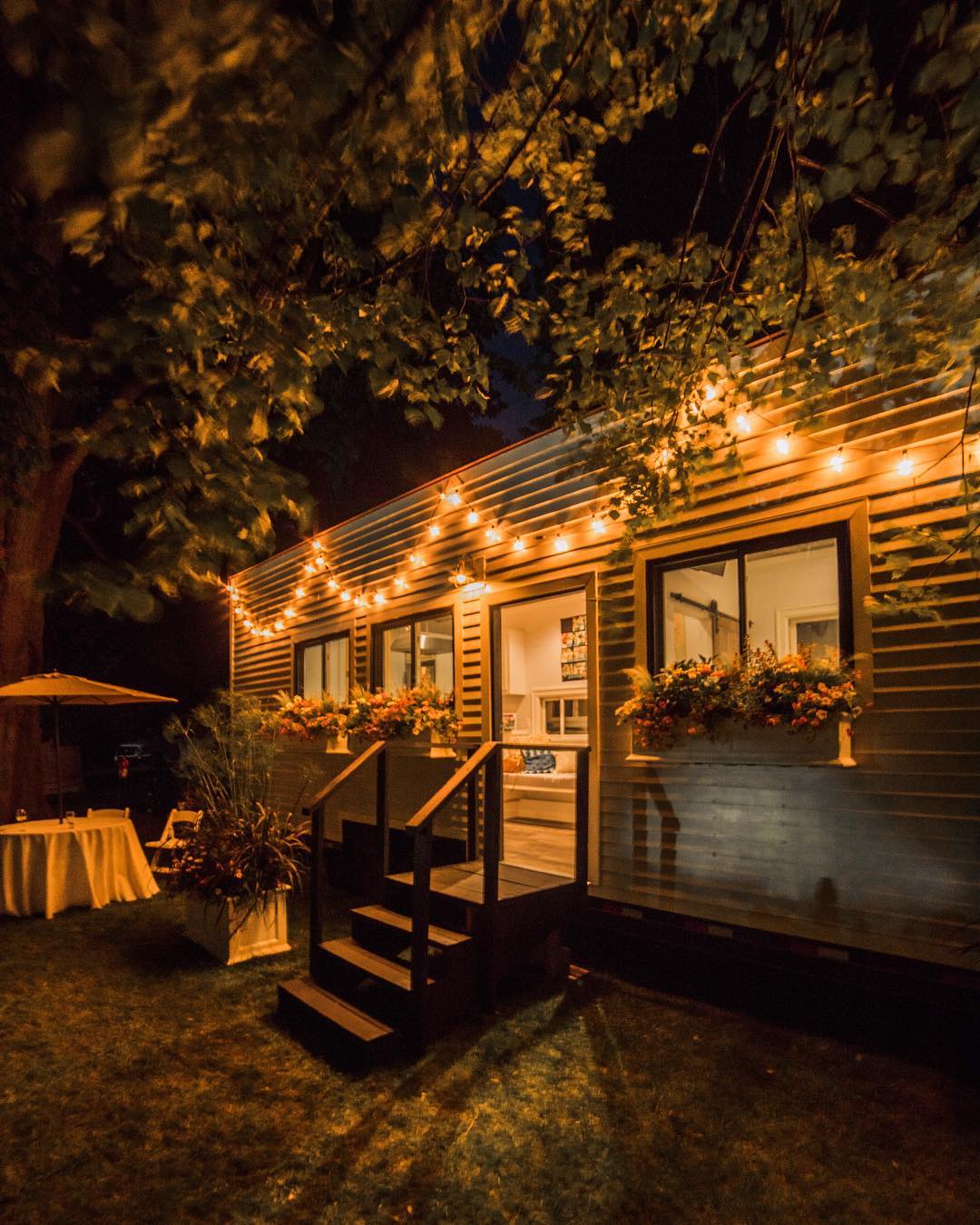
3. On that note, use multi-use and consumable seasonal decor. For holidays, I prefer to use in-season flowers and greenery from my local garden center rather than objects I’ll have to store in the off-season. I also use decor that’s appropriate for multiple holidays, like white bistro lights, rather than specifically red and green lights for Christmas that can’t then be used again for Independence Day. My house truly gets in the Christmas spirit when my plates are heaped with gingerbread cookies; my visitors don’t need to see those cookies on a Santa plate to be put in the holiday spirit!
4. Digitize your photos and files: an external hard drive takes up much less room than a file cabinet. The process of going through photos and memories is a great way to connect to your past and get ready for your future, and it may be the only time in your life you’ll do so! Books can be sentimental objects, so keep the ones that mean the most to you, but all others can be checked out of a library or read on an electronic device.
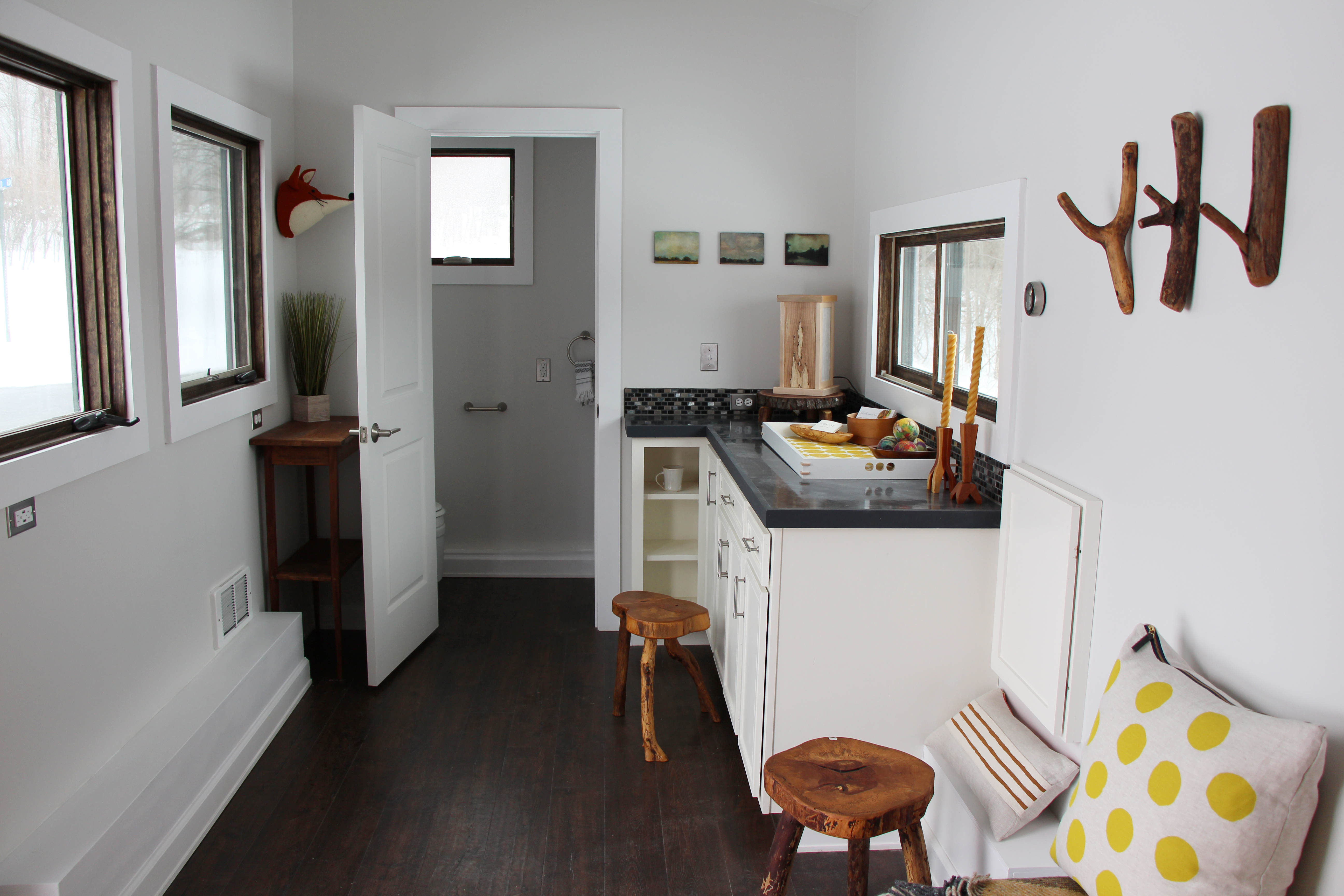
5. If you live in a cold climate, be sure to dedicate a space in your tiny house for coats and outdoor gear that’s separate from your regular clothing storage. That way, when you come in from a blizzard and peel off your boots and jacket they won’t get the rest of your clothes wet.
6. Think outside the house. While your tiny house might not be able to fit a full chef’s kitchen or large lounge area, consider your deck or yard an outdoor kitchen and living room. In addition to expanding your culinary offerings, grilling can be healthier, and in the summer, you’ll save energy by not heating your home with your oven or stove. Set up lounge chairs or an outdoor sectional and spend more time outdoors.
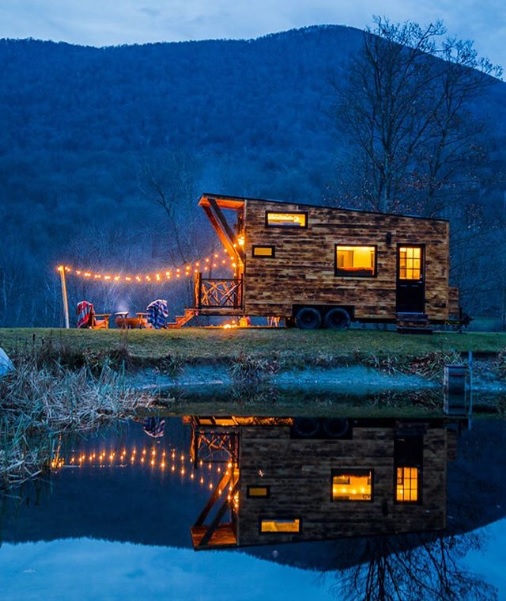
Photo: Kyle Finn Dempsey
7. Save your indoor space for the objects you use every day. Invest in a storage shed to house things you won’t need to keep inside: vacuum-packed off-season clothing, craft supplies, outdoor gear. If you’re skirting your tiny house, build a door or gate in your skirting so you can store skis, surfboards, bikes, and outdoor furniture underneath.
8. In your previous house or apartment, you may have had windows on only one or two sides of each room. In a tiny house, you’ll have windows on all sides of you, and you’ll be closer to your windows at all times. While this is spectacular in daylight, when night falls you’ll want them to be covered. Choose light-blocking, thermally insulated window coverings for your privacy and comfort.
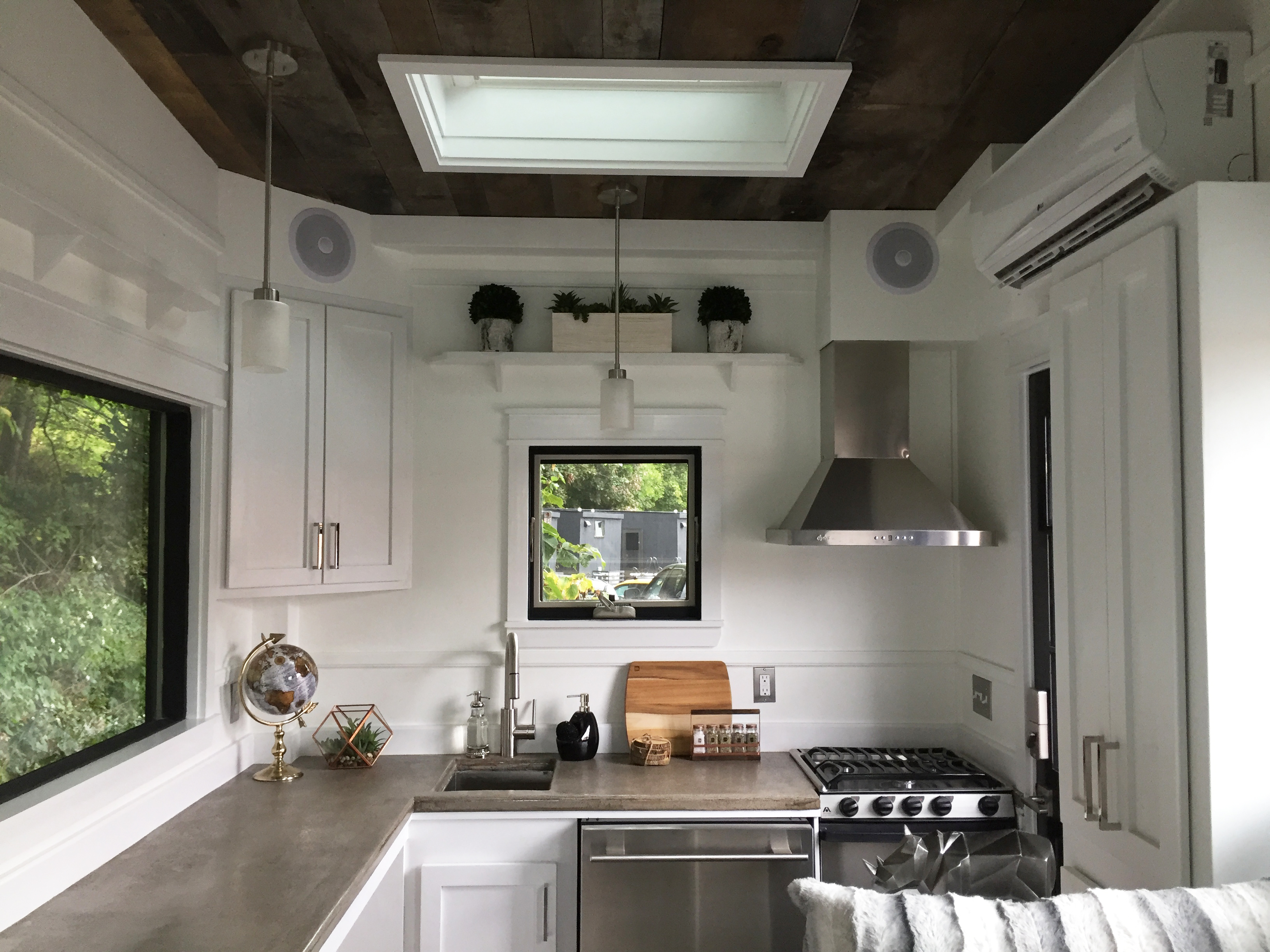
9. Look into community sharing programs. Everything from bikes to clothing to lawn equipment can be shared, either in a neighborhood or through a rental app. Some public libraries even have a “Library of Things”, where you can check out a theremin, a Check Engine scanner for your car, or a video projector when you want to have a movie night (to celebrate the start of summer season, this author hosted a screening of Wet Hot American Summer for her friends with the help of her local library). Your tiny house might not have a guest room, but visitors can always stay in a nearby AirBnb.
10. Get involved in community activities. If you enjoy stretching and physical activity, you’ll have less room for that inside a tiny house, so go to a gym, yoga studio, or dance studio. Likewise, exchange your home office for your public library, local coworking space or coffee shop. Instead of a home theater, support your local independent movie theater and community playhouse. Take advantage of inexpensive or free community programming, like adult education classes, group hikes, and cooking classes hosted by your local Parks & Rec department or Meetup.com. By thinking of your community as an extension of your home, you’ll end up healthier, more invested in your neighborhood, and with an expanded social circle.
Put Your Life on a Diet: Lessons Learned Living in 140 Square Feet by Gregory Johnson
Gregory is considered one of the founders of the American tiny house movement. This book is where the hanger trick came from!
The Life-Changing Magic of Tidying Up: The Japanese Art of Decluttering and Organizing by Marie Kondo
If you haven’t heard of Marie Kondo then it seems you’ve already downsized your media consumption as well. She’s currently the world’s most famous expert on decluttering.
Downsizing The Family Home: What to Save, What to Let Go by Marni Jameson for AARP
Published by the AARP, this book offers advice on downsizing an older relative’s home.
What downsizing tips did we miss? Email us at [email protected] to let us know!

Before having your tiny house built, you should already have a spot to put it lined up. You don’t want to end up with a tiny house and nowhere to put it!
Because tiny houses are a relatively new phenomenon, most municipalities have never had anyone approach them to ask whether they can live in a tiny house. Therefore, most municipalities don’t have any bylaws saying you can or can’t live specifically in a tiny house. Use this guide to learn what you’ll need to know to get the perfect parking spot for your tiny house.
The 8 Steps To Buying A Tiny House: Everything You’ll Need To Do To Go Tiny
This post covers your entire tiny house buying process, and the first and most important step is finding a place to put it. Whether you’ll be buying or renting land, familiarize yourself with the tiny house buying process and how long it’ll take, before starting to your land search.
Here, you’ll learn how to find and read your town or city’s zoning laws to find out whether there are already rules for tiny houses, whether on foundations or on wheels. If your town doesn’t have laws pertaining to tiny houses, you’ll learn how to approach your town to ask. Importantly, you’ll also learn what to look for in the land, including hookups for fresh water, waste water, and power.
Where Can I Put My Tiny House? A Near-Comprehensive List Of Tiny House Parking Resources
Now that you know how to look for zoning laws and get permission to live in your tiny house, you’ll need to do some networking to find a spot for it! Facebook and Meetup are both great networking sites for tiny house enthusiasts, and this list links to Facebook and Meetup groups about tiny houses in almost every state. In addition to networking on tiny house specific sites and groups, advertise on local forums on Facebook, Craigslist, and community bulletin boards asking for those willing to rent out or sell land for a tiny house. The sooner you find land the sooner you can get started with the build. Good luck, and let us know how your land search goes!

Arcadia Tiny House at Woodlife Ranch. Photo by Kyle Finn Dempsey
Learn more about our process or fill out the form below and one of our tiny house experts will reach out to you.
